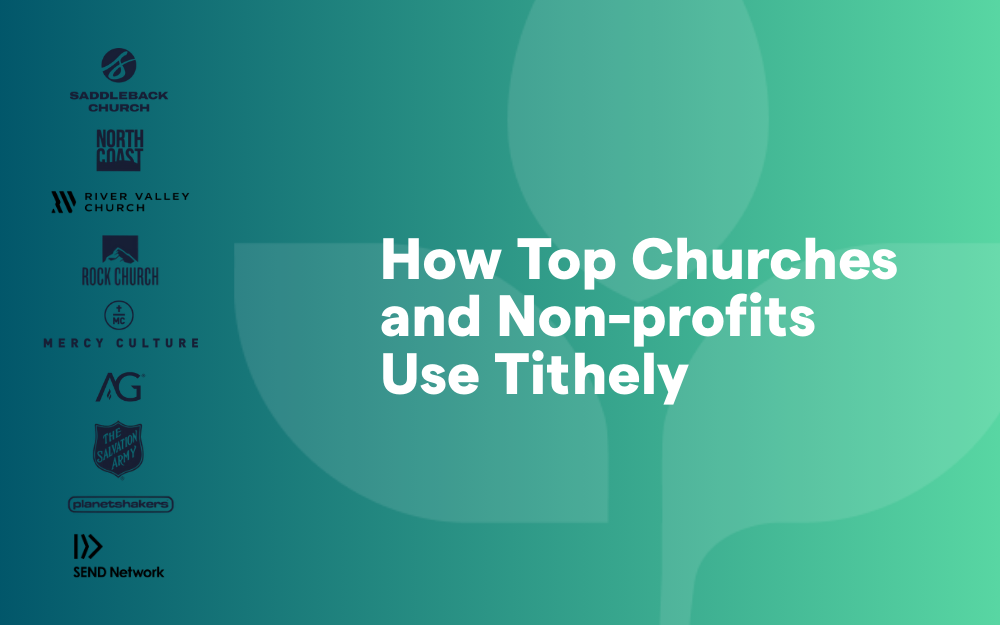How Churches Manage Financial Growth: A Biblical Guide
Learn how to manage fast financial growth in your church so that it doesn’t do more harm than good.

Church financial growth is often a blessing.
Many churches do not struggle with growing financially too quickly.
However, many churches miss moments of opportunity to grow because they do not manage an increase in funds in a way that perpetuates giving. As a consequence, giving drops, and the growth is seen as a “spike in giving,” rather than an opportunity to operate at a much higher caliber for generations to come.
Here, we are going to unpack the nature of church financial growth, the struggles associated with an increase in giving, and relevant strategies that churches can employ to transform increases in giving into life-long financial prosperity which resources their ministry to the hurting in their community at a factor which scales.
1. Growth often requires cost
“He who supplies seed to the sower and bread for food will supply and multiply your seed for sowing and increase the harvest of your righteousness” (2 Cor. 9:10).
Anyone who has ever grown anything knows this.
Start with a plant. What do you need? A seed.
Then, you need soil, water, and sunlight.
Then, you need gardening tools.
Then, as your garden grows, you need a fence to keep rabbits from eating all of your produce.
Then, you need kitchen equipment to prepare the food for consumption.
Growth never costs nothing. But that’s not a bad thing. Humans generally like to eat things from gardens. Even your favorite cake started in a garden or farm—from the wheat to the sugar to the eggs to the milk. It was cultivated through effort, and every phase of production that caused growth cost the gardener or farmer something.
The same goes for church growth.
With more people comes the need for more money to serve those people well. And with more money comes more liability, more people who want access to that money, and more wisdom about how that money is spent.
So, when you grow, don’t interpret growth cost as a threat to your church. Embrace the cost of growth with faith that God has big plans for your church.
2. Growth often requires complexity
“Count it all joy, my brothers, when you meet trials of various kinds, for you know that the testing of your faith produces steadfastness. And let steadfastness have its full effect, that you may be perfect and complete, lacking in nothing” (Jam. 1:2–4).
Growth not only comes at a cost, but often requires more complex systems. The human body is vastly more complex than a single-cell organism, but it is also vastly more capable, powerful, and effective.
Church growth works the same way.
As membership grows, the need for church staff grows in proportion to the systems required to reach, disciple, and manage those members well.
Just as you embrace growth cost, embrace growth complexity. Such an embrace signifies maturation in your organization’s leadership.
3. Growth often requires change
“Desire without knowledge is not good, and whoever makes haste with his feet misses his way” (Prov. 19:2).
Growth always requires change.
Change in roles and responsibilities. Change in church culture. Change in preference. Change in need. Change in resource allocation.
The church you lead is made of people. It is inevitable that as more people join your church, the nature of that church will change as new people with new personalities, preferences, giftings, and backgrounds begin to call your church “home.”
The effort of embracing the cost and complexity of growth is negligible when compared with the effort it requires to embrace change in your organization.
If you want to see how much people hate change, try painting one wall in your sanctuary a different color and see how people react. That single act could cause a church split.
Part of your job as a church leader is to help your membership see the forest through the trees and embrace the fact that growth always requires change. This is a matter of the heart and, as such, falls within your domain as a church leader.
4. How to prevent growth from becoming a spike
The best way to prevent financial growth from becoming a one-time “spike” in your financial reports is to modify your church fundraising model.
Most churches have regular givers who have to opt in every single time they want to give to the church.
Instead of asking your entire congregation for one-time gifts every week (which is much less than many churches do), invite your congregation to participate in God’s ongoing work through your church by setting up recurring giving.
Many churches try this once and fail because, they report, church members don’t take digital giving seriously.
But at Tithe.ly, we have found that congregants take digital giving as seriously as the church leadership takes it. If your congregants sense that the church leadership team is taking the use of digital giving software very seriously and that it is highly desirable, they will participate, very often without objection.
In order to communicate that you take digital giving seriously, hold membership training sessions to help people get set up with your digital giving tool such as Tithe.ly Giving.
Emphasize that by setting up a recurring gift through your church app, your members are helping your church achieve financial stability and escape the seasonal financial volatility common among churches.
Over to you
“And let us not grow weary of doing good, for in due season we will reap, if we do not give up” (Gal. 6:9).
These insights will help your church to strategically leverage fluctuations in giving into a reliable boost in overall giving for years to come.
This requires patience, carefully devised strategies, and a vision for change that will inspire members in your congregation to give.
But what it requires, it will return tenfold if implemented seriously and correctly.
May God bless your church in its endeavor to relieve pain in its community and to bring the gospel of Jesus Christ to the hurting and lost inside and outside your walls.
Sign Up for Product Updates
Church financial growth is often a blessing.
Many churches do not struggle with growing financially too quickly.
However, many churches miss moments of opportunity to grow because they do not manage an increase in funds in a way that perpetuates giving. As a consequence, giving drops, and the growth is seen as a “spike in giving,” rather than an opportunity to operate at a much higher caliber for generations to come.
Here, we are going to unpack the nature of church financial growth, the struggles associated with an increase in giving, and relevant strategies that churches can employ to transform increases in giving into life-long financial prosperity which resources their ministry to the hurting in their community at a factor which scales.
1. Growth often requires cost
“He who supplies seed to the sower and bread for food will supply and multiply your seed for sowing and increase the harvest of your righteousness” (2 Cor. 9:10).
Anyone who has ever grown anything knows this.
Start with a plant. What do you need? A seed.
Then, you need soil, water, and sunlight.
Then, you need gardening tools.
Then, as your garden grows, you need a fence to keep rabbits from eating all of your produce.
Then, you need kitchen equipment to prepare the food for consumption.
Growth never costs nothing. But that’s not a bad thing. Humans generally like to eat things from gardens. Even your favorite cake started in a garden or farm—from the wheat to the sugar to the eggs to the milk. It was cultivated through effort, and every phase of production that caused growth cost the gardener or farmer something.
The same goes for church growth.
With more people comes the need for more money to serve those people well. And with more money comes more liability, more people who want access to that money, and more wisdom about how that money is spent.
So, when you grow, don’t interpret growth cost as a threat to your church. Embrace the cost of growth with faith that God has big plans for your church.
2. Growth often requires complexity
“Count it all joy, my brothers, when you meet trials of various kinds, for you know that the testing of your faith produces steadfastness. And let steadfastness have its full effect, that you may be perfect and complete, lacking in nothing” (Jam. 1:2–4).
Growth not only comes at a cost, but often requires more complex systems. The human body is vastly more complex than a single-cell organism, but it is also vastly more capable, powerful, and effective.
Church growth works the same way.
As membership grows, the need for church staff grows in proportion to the systems required to reach, disciple, and manage those members well.
Just as you embrace growth cost, embrace growth complexity. Such an embrace signifies maturation in your organization’s leadership.
3. Growth often requires change
“Desire without knowledge is not good, and whoever makes haste with his feet misses his way” (Prov. 19:2).
Growth always requires change.
Change in roles and responsibilities. Change in church culture. Change in preference. Change in need. Change in resource allocation.
The church you lead is made of people. It is inevitable that as more people join your church, the nature of that church will change as new people with new personalities, preferences, giftings, and backgrounds begin to call your church “home.”
The effort of embracing the cost and complexity of growth is negligible when compared with the effort it requires to embrace change in your organization.
If you want to see how much people hate change, try painting one wall in your sanctuary a different color and see how people react. That single act could cause a church split.
Part of your job as a church leader is to help your membership see the forest through the trees and embrace the fact that growth always requires change. This is a matter of the heart and, as such, falls within your domain as a church leader.
4. How to prevent growth from becoming a spike
The best way to prevent financial growth from becoming a one-time “spike” in your financial reports is to modify your church fundraising model.
Most churches have regular givers who have to opt in every single time they want to give to the church.
Instead of asking your entire congregation for one-time gifts every week (which is much less than many churches do), invite your congregation to participate in God’s ongoing work through your church by setting up recurring giving.
Many churches try this once and fail because, they report, church members don’t take digital giving seriously.
But at Tithe.ly, we have found that congregants take digital giving as seriously as the church leadership takes it. If your congregants sense that the church leadership team is taking the use of digital giving software very seriously and that it is highly desirable, they will participate, very often without objection.
In order to communicate that you take digital giving seriously, hold membership training sessions to help people get set up with your digital giving tool such as Tithe.ly Giving.
Emphasize that by setting up a recurring gift through your church app, your members are helping your church achieve financial stability and escape the seasonal financial volatility common among churches.
Over to you
“And let us not grow weary of doing good, for in due season we will reap, if we do not give up” (Gal. 6:9).
These insights will help your church to strategically leverage fluctuations in giving into a reliable boost in overall giving for years to come.
This requires patience, carefully devised strategies, and a vision for change that will inspire members in your congregation to give.
But what it requires, it will return tenfold if implemented seriously and correctly.
May God bless your church in its endeavor to relieve pain in its community and to bring the gospel of Jesus Christ to the hurting and lost inside and outside your walls.
podcast transcript
Church financial growth is often a blessing.
Many churches do not struggle with growing financially too quickly.
However, many churches miss moments of opportunity to grow because they do not manage an increase in funds in a way that perpetuates giving. As a consequence, giving drops, and the growth is seen as a “spike in giving,” rather than an opportunity to operate at a much higher caliber for generations to come.
Here, we are going to unpack the nature of church financial growth, the struggles associated with an increase in giving, and relevant strategies that churches can employ to transform increases in giving into life-long financial prosperity which resources their ministry to the hurting in their community at a factor which scales.
1. Growth often requires cost
“He who supplies seed to the sower and bread for food will supply and multiply your seed for sowing and increase the harvest of your righteousness” (2 Cor. 9:10).
Anyone who has ever grown anything knows this.
Start with a plant. What do you need? A seed.
Then, you need soil, water, and sunlight.
Then, you need gardening tools.
Then, as your garden grows, you need a fence to keep rabbits from eating all of your produce.
Then, you need kitchen equipment to prepare the food for consumption.
Growth never costs nothing. But that’s not a bad thing. Humans generally like to eat things from gardens. Even your favorite cake started in a garden or farm—from the wheat to the sugar to the eggs to the milk. It was cultivated through effort, and every phase of production that caused growth cost the gardener or farmer something.
The same goes for church growth.
With more people comes the need for more money to serve those people well. And with more money comes more liability, more people who want access to that money, and more wisdom about how that money is spent.
So, when you grow, don’t interpret growth cost as a threat to your church. Embrace the cost of growth with faith that God has big plans for your church.
2. Growth often requires complexity
“Count it all joy, my brothers, when you meet trials of various kinds, for you know that the testing of your faith produces steadfastness. And let steadfastness have its full effect, that you may be perfect and complete, lacking in nothing” (Jam. 1:2–4).
Growth not only comes at a cost, but often requires more complex systems. The human body is vastly more complex than a single-cell organism, but it is also vastly more capable, powerful, and effective.
Church growth works the same way.
As membership grows, the need for church staff grows in proportion to the systems required to reach, disciple, and manage those members well.
Just as you embrace growth cost, embrace growth complexity. Such an embrace signifies maturation in your organization’s leadership.
3. Growth often requires change
“Desire without knowledge is not good, and whoever makes haste with his feet misses his way” (Prov. 19:2).
Growth always requires change.
Change in roles and responsibilities. Change in church culture. Change in preference. Change in need. Change in resource allocation.
The church you lead is made of people. It is inevitable that as more people join your church, the nature of that church will change as new people with new personalities, preferences, giftings, and backgrounds begin to call your church “home.”
The effort of embracing the cost and complexity of growth is negligible when compared with the effort it requires to embrace change in your organization.
If you want to see how much people hate change, try painting one wall in your sanctuary a different color and see how people react. That single act could cause a church split.
Part of your job as a church leader is to help your membership see the forest through the trees and embrace the fact that growth always requires change. This is a matter of the heart and, as such, falls within your domain as a church leader.
4. How to prevent growth from becoming a spike
The best way to prevent financial growth from becoming a one-time “spike” in your financial reports is to modify your church fundraising model.
Most churches have regular givers who have to opt in every single time they want to give to the church.
Instead of asking your entire congregation for one-time gifts every week (which is much less than many churches do), invite your congregation to participate in God’s ongoing work through your church by setting up recurring giving.
Many churches try this once and fail because, they report, church members don’t take digital giving seriously.
But at Tithe.ly, we have found that congregants take digital giving as seriously as the church leadership takes it. If your congregants sense that the church leadership team is taking the use of digital giving software very seriously and that it is highly desirable, they will participate, very often without objection.
In order to communicate that you take digital giving seriously, hold membership training sessions to help people get set up with your digital giving tool such as Tithe.ly Giving.
Emphasize that by setting up a recurring gift through your church app, your members are helping your church achieve financial stability and escape the seasonal financial volatility common among churches.
Over to you
“And let us not grow weary of doing good, for in due season we will reap, if we do not give up” (Gal. 6:9).
These insights will help your church to strategically leverage fluctuations in giving into a reliable boost in overall giving for years to come.
This requires patience, carefully devised strategies, and a vision for change that will inspire members in your congregation to give.
But what it requires, it will return tenfold if implemented seriously and correctly.
May God bless your church in its endeavor to relieve pain in its community and to bring the gospel of Jesus Christ to the hurting and lost inside and outside your walls.
VIDEO transcript
Church financial growth is often a blessing.
Many churches do not struggle with growing financially too quickly.
However, many churches miss moments of opportunity to grow because they do not manage an increase in funds in a way that perpetuates giving. As a consequence, giving drops, and the growth is seen as a “spike in giving,” rather than an opportunity to operate at a much higher caliber for generations to come.
Here, we are going to unpack the nature of church financial growth, the struggles associated with an increase in giving, and relevant strategies that churches can employ to transform increases in giving into life-long financial prosperity which resources their ministry to the hurting in their community at a factor which scales.
1. Growth often requires cost
“He who supplies seed to the sower and bread for food will supply and multiply your seed for sowing and increase the harvest of your righteousness” (2 Cor. 9:10).
Anyone who has ever grown anything knows this.
Start with a plant. What do you need? A seed.
Then, you need soil, water, and sunlight.
Then, you need gardening tools.
Then, as your garden grows, you need a fence to keep rabbits from eating all of your produce.
Then, you need kitchen equipment to prepare the food for consumption.
Growth never costs nothing. But that’s not a bad thing. Humans generally like to eat things from gardens. Even your favorite cake started in a garden or farm—from the wheat to the sugar to the eggs to the milk. It was cultivated through effort, and every phase of production that caused growth cost the gardener or farmer something.
The same goes for church growth.
With more people comes the need for more money to serve those people well. And with more money comes more liability, more people who want access to that money, and more wisdom about how that money is spent.
So, when you grow, don’t interpret growth cost as a threat to your church. Embrace the cost of growth with faith that God has big plans for your church.
2. Growth often requires complexity
“Count it all joy, my brothers, when you meet trials of various kinds, for you know that the testing of your faith produces steadfastness. And let steadfastness have its full effect, that you may be perfect and complete, lacking in nothing” (Jam. 1:2–4).
Growth not only comes at a cost, but often requires more complex systems. The human body is vastly more complex than a single-cell organism, but it is also vastly more capable, powerful, and effective.
Church growth works the same way.
As membership grows, the need for church staff grows in proportion to the systems required to reach, disciple, and manage those members well.
Just as you embrace growth cost, embrace growth complexity. Such an embrace signifies maturation in your organization’s leadership.
3. Growth often requires change
“Desire without knowledge is not good, and whoever makes haste with his feet misses his way” (Prov. 19:2).
Growth always requires change.
Change in roles and responsibilities. Change in church culture. Change in preference. Change in need. Change in resource allocation.
The church you lead is made of people. It is inevitable that as more people join your church, the nature of that church will change as new people with new personalities, preferences, giftings, and backgrounds begin to call your church “home.”
The effort of embracing the cost and complexity of growth is negligible when compared with the effort it requires to embrace change in your organization.
If you want to see how much people hate change, try painting one wall in your sanctuary a different color and see how people react. That single act could cause a church split.
Part of your job as a church leader is to help your membership see the forest through the trees and embrace the fact that growth always requires change. This is a matter of the heart and, as such, falls within your domain as a church leader.
4. How to prevent growth from becoming a spike
The best way to prevent financial growth from becoming a one-time “spike” in your financial reports is to modify your church fundraising model.
Most churches have regular givers who have to opt in every single time they want to give to the church.
Instead of asking your entire congregation for one-time gifts every week (which is much less than many churches do), invite your congregation to participate in God’s ongoing work through your church by setting up recurring giving.
Many churches try this once and fail because, they report, church members don’t take digital giving seriously.
But at Tithe.ly, we have found that congregants take digital giving as seriously as the church leadership takes it. If your congregants sense that the church leadership team is taking the use of digital giving software very seriously and that it is highly desirable, they will participate, very often without objection.
In order to communicate that you take digital giving seriously, hold membership training sessions to help people get set up with your digital giving tool such as Tithe.ly Giving.
Emphasize that by setting up a recurring gift through your church app, your members are helping your church achieve financial stability and escape the seasonal financial volatility common among churches.
Over to you
“And let us not grow weary of doing good, for in due season we will reap, if we do not give up” (Gal. 6:9).
These insights will help your church to strategically leverage fluctuations in giving into a reliable boost in overall giving for years to come.
This requires patience, carefully devised strategies, and a vision for change that will inspire members in your congregation to give.
But what it requires, it will return tenfold if implemented seriously and correctly.
May God bless your church in its endeavor to relieve pain in its community and to bring the gospel of Jesus Christ to the hurting and lost inside and outside your walls.




























